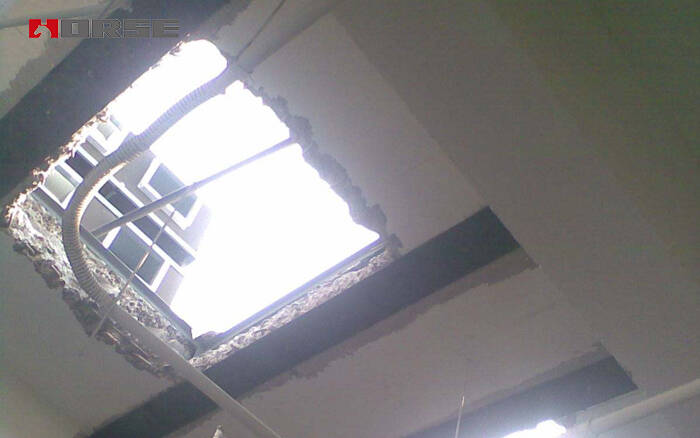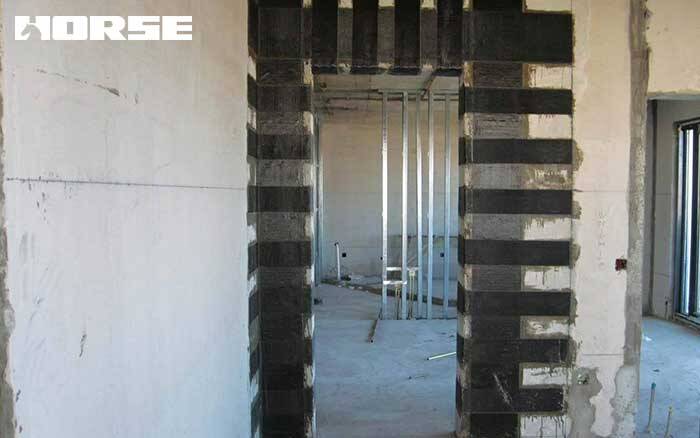Solutions
Horse Construction offers full range of structural strengthening materials with technical supports, documentation supports, products supports, project supports.
How to Know When an Opening Needs Structural Strengthening?

There are many potential safety hazards after opening
Holes in the floor will have more adverse effects on the floor.
First of all, the opening of the floor will reduce the overall rigidity of the floor and reduce the structural integrity. Decreasing the stiffness of the floor slab will affect the seismic performance of the building. When an earthquake occurs, the floor slab is easily deformed and damaged.
On the other hand, the opening of the floor will not only cause stress concentration at the opening, but also weaken the bearing capacity of the floor around the opening. When the load increases, insufficient bearing capacity may occur around the opening, causing concrete cracking or even damage.
Therefore, when opening the floor, the structure should be reinforced according to the actual situation.
No matter the size of the hole in the floor, it will have a certain impact on the structural integrity and cause certain damage to the bearing capacity of the floor. Only by attaching importance to the later reinforcement treatment, choosing appropriate reinforcement technology and high-quality and safe reinforcement materials, can the structural safety be guaranteed in the long run. The choice of reinforcement method varies depending on the size of the floor opening. It can be judged separately according to the size of the opening and the number of steel cuts, and then an appropriate reinforcement method is adopted.
Precautions for floor opening reinforcement
1. When performing floor opening and reinforcement, first of all, the operation of floor opening cannot be problematic. If you are wrong when you are opening the floor, the existence of problems will affect the subsequent reinforcement operations. In this way, you will feel very troubled during the reinforcement process, and the reinforcement work may not be carried out smoothly. Therefore, when performing the reinforcement operation of the floor opening, make sure that there can be no problems with your floor opening process.
2. Your reinforcement technique should be very good when opening holes in the floor. This so-called technology requires everyone to mean that you need to pay full attention to operations, procedures, and precautions when you perform reinforcement. Only in this way can you ensure that you will not be affected by bad factors when you are strengthening, and the final reinforcement effect can be best guaranteed.
3. If you are unprofessional when opening holes in the floor slab reinforcement, it is best to ask professional reinforcement company constructors to help. They usually have relatively rich technical experience for these, and you will save some trouble during the service process, and you don't need to worry about construction.

How to strengthen the floor after opening a hole
Bonded steel reinforcement
The cast-in-place continuous slab has holes. When the hole position is located in the negative bending moment area of the slab, when sticking steel is used as compensation reinforcement, it should be reinforced on both sides. For the sticking steel plate reinforcement method, the direction of greater force should be pasted on the outermost layer, and the direction of less force should be pasted on the inner layer. At this time, the first-bonded steel plate should be grooved at the concrete veneer. The thickness of the groove is ≥ the thickness of the steel plate + 3mm to ensure that the surface of the first-bonded steel plate is flush with the floor. It can also be glued in two directions, but it is necessary to cut the steel plate in the direction of less force into three sections, weld on site, and pour adhesive after the partial.
related requirements
a. The steel plate selection specification should be 100mm~200mm wide and 3mm~5mm thick.
b. This reinforcement method can only be used for structural reinforcement if the opening is small.
c. The area of the compensation steel plate shall not be less than 1.2 times the equivalent cross-sectional area of the truncated steel bars.
Carbon fiber reinforcement:
The cast-in-place continuous slab has holes. When the hole is located in the negative bending moment area of the slab, when the bonding carbon cloth is used for reinforcement, double-sided reinforcement should also be carried out. The order of the vertical and horizontal fiber cloths is not restricted.
related requirements:
a. The specification of carbon cloth is 200mm~500mm wide and 200g~600g mass.
b. This reinforcement method can only be used for structural reinforcement if the opening is small.
c. The maximum tensile value of the compensation carbon cloth shall not be less than 1.2 times the equivalent tensile value of the truncated steel bars.
d. When the carbon cloth is in contact with the steel plate, a layer of adhesive should be applied instead of direct contact.
Add concrete side beams
When the slab opening is further expanded, causing the width or diameter of the opening to be greater than 1000mm, or the number of cut steel bars exceeds 20%, and when there is a large concentrated load at the opening, the prefabricated slab cuts the main rib, etc., only carbon fiber cloth or steel plate is used. The reinforcement effect will be very limited. The force transmission path should be changed to reduce the adverse effect of stress concentration on the force of the floor. To change the stress transfer, a new beam at the opening can be used for support transfer. When using this method, it is necessary to pay attention to whether the original structure needs to be reinforced in the vertical and horizontal directions, and to ensure the effective transfer of shear force.
Additional steel beam
The hole cut after the hole is generally turned up, the steel bar of the hole is cut and bent upward, and the edge of the hole is chiseled and turned up. The height of the flanging is not less than 100mm, the thickness is not less than 80mm, and the strength level of the flanging concrete is not less than that of the original concrete slab. The steel beam placed on the edge of the hole can be I-beam, channel steel or angle steel, and the specific amount is determined by calculation.
You can find anything here you are in need of, have a trust trying on these products, you will find the big difference after that.

Two-component epoxy modified epoxy structural strengthening adhesive for bonded steel plate to concrete

Modified epoxy resin structural perfusion adhesive, specifically for supporting adhesive bonded steel reinforcement

High strength, unidirectional carbon fiber sheet pre-saturated to form a carbon fiber reinforced polymer (CFRP) sheet used to strengthen structural concrete elements.